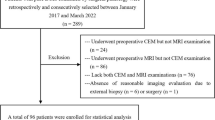Abstract
Purpose
This study sought to determine the prevalence of extramammary findings on magnetic resonance (MR) imaging of the breast.
Materials and methods
We retrospectively reviewed the data sets of 828 consecutive patients (F/M; 821/7; mean age, 50±11 years) who underwent breast MR imaging. The most common clinical indication was assessment of lesion extent in patients with known breast tumour (n=380, 46%), characterisation of equivocal findings at conventional imaging (n=331, 40%), evaluation of women at high risk for breast cancer (n=43, 5%) and following breast augmentation therapy (n=74, 9%).
Results
Collateral findings were found in 282/828 (34%) patients. In those 282 patients, 480 incidental lesions were detected. The most common localisation was the liver (231/480; 48%). Of the 480 collateral findings, 66 (14% in 38 patients) were classified as significant and deserving further investigation. These comprised 26 metastatic bony lesions, 15 mediastinal/axillary lymph nodes, six metastatic lung lesions, five metastatic liver lesions, four pneumonitis, two aneurysms of the ascending aorta, two adrenal adenomas, one neurofibroma of the back, one multiple myeloma, one mediastinal lymphoma, one sternal amyloidosis, one left ventricular dilatation and one trapezium lipoma.
Conclusions
There is a high prevalence of extramammary findings on breast MR imaging. Evaluation of the examination should focus not only on the breast fields but also consider extramammary findings to avoid inappropriate management and possible legal issues.
Riassunto
Obiettivo
Scopo di questo lavoro è determinare la prevalenza di reperti extra-mammari alla RM della mammella.
Materiali e metodi
Sono stati analizzati 828 pazienti (F/M 821/7, età media 50±11 anni), sottoposti a esame RM della mammella. Le indicazione cliniche all’esame RM, sono state la valutazione dell’estensione di malattia in pazienti con neoplasia mammaria nota (380, 46%), la caratterizzazione di lesioni indeterminate all’imaging convenzionale (331, 40%), lo studio di pazienti ad alto rischio per eteroplasia mammaria (43, 5%) e di pazienti sottoposte a mastoplastica additiva (74, 9%).
Risultati
Sono stati riscontrati reperti collaterali in 282/828 (34%) pazienti. Nelle 282 pazienti con reperti collaterali, è stato riscontrato un totale di 480 lesioni incidentali. La più comune localizzazione è stata il fegato con 231/480 casi (48%). Dei 480 reperti collaterali, 66 (14% in 38 pazienti) sono stati considerati significativi e meritevoli di ulteriore approfondimento diagnostico. Di questi, 26 risultavano lesioni ossee metastatiche, 15 linfonodi mediastinici e/o ascellari, 6 metastasi polmonari, 5 metastasi epatiche, 4 polmoniti, 2 aneurismi dell’aorta ascendente, 2 adenomi surrenalici, 1 neurofibroma del dorso, 1 mieloma multiplo, 1 linfoma mediastinico, 1 amiloidosi sternale, 1 cardiomiopatia dilatativa, 1 lipoma del trapezio.
Conclusioni
La prevalenza di reperti extra-mammari è alta nelle pazienti sottoposte a RM della mammella. Nell’interpretazione di un esame RM della mammella, risulta indispensabile anche la valutazione delle strutture extra-ghiandolari, per evitare terapie inadeguate e possibili problematiche medico-legali.
Similar content being viewed by others
References/Bibliografia
Vassiou K, Kanavou T, Vlychou M et al (2009) Characterization of breast lesions with CE-MR multimodal morphological and kinetic analysis: comparison with conventional mammography and high-resolution ultrasound. Eur J Radiol 70:69–76
Kriege M, Brekelmans CT, Boetes C et al (2004) Efficacy of MRI and mammography for breast-cancer screening in women with a familial or genetic predisposition. N Engl J Med 351:427–437
Heywang SH, Hilbertz T, Beck R et al (1990) Gd-DTPA enhanced MR imaging of the breast in patients with postoperative scarring and silicon implants. J Comput Assist Tomogr 14:348–356
Kuhl CK (2006) Concepts for differential diagnosis in breast MR imaging. Magn Reson Imaging Clin N Am 14:305–328
Kuhl CK (2006) MR imaging for surveillance of women at high familial risk for breast cancer. Magn Reson Imaging Clin N Am 14:391–402
Leach MO, Boggis CR, Dixon AK et al (2005) Screening with magnetic resonance imaging and mammography of a UK population at high familial risk of breast cancer: a prospective multicentre cohort study (MARIBS). Lancet 365:1769–1778
Luciani ML, Pediconi F, Telesca M et al (2011) Incidental enhancing lesions found on preoperative breast MRI: management and role of second-look ultrasound. Radiol Med 116:886–904
Hill KA, Rosen B, Shaw P et al (2007) Incidental MRI detection of BRCA1-related solitary peritoneal carcinoma during breast screening. A case report. Gynecol Oncol 107:136–139
Rausch DR (2008) Spectrum of extramammary findings on breast MRI: a pictorial review. Breast J 14:591–600
Lehman CD, Isaacs C, Schnall MR et al (2007) Cancer yield of mammography, MR and US in high risk women: prospective multi-institution breast cancer screening study. Radiology 244:381–388
Li SP, Makris A, Beresford MJ et al (2011) Use of dynamic contrast-enhanced MR imaging to predict survival in patients with primary breast cancer undergoing neoadjuvant chemotherapy. Radiology 260:68–78
Morakkabati-Spitz N, Sondermann E, Schmiedel A et al (2003) Prevalence and type of incidental extra-mammary findings in MRI of the breast. Rofo 175:199–202
Rinaldi P, Costantini M, Belli P et al (2011) Extra-mammary findings in breast MRI. Eur Radiol 21:2268–2276
Khalil HI, Patterson SA, Panicek DM (2005) Hepatic lesions deemed too small to characterize at CT: prevalence and importance in women with breast cancer. Radiology 235:872–878
Schwartz LH, Gandras EJ, Colangelo SM et al (1999) Prevalence and importance of small hepatic lesions found at CT in patients with cancer. Radiology 210:71–74
Godersky JC, Smoker WR, Knutson RK (1987) Use of magnetic resonance imaging in the evaluation of metastatic spinal disease. Neurosurgery 21:676–680
Jones AL, Williams MP, Powles TJ et al (1990) Magnetic resonance imaging in the detection of skeletal metastases in patients with breast cancer. Br J Cancer 62:296–298
Smoker WR, Godersky JC, Knutzon RK et al (1987) The role of MR imaging in evaluating metastatic spinal disease. AJR 149:1241–1248
Yoshimura G, Sakurai T, Oura S et al (1999) Evaluation of axillary lymph node status in breast cancer with MRI. Breast Cancer 6:249–258
Author information
Authors and Affiliations
Corresponding author
Rights and permissions
About this article
Cite this article
Iodice, D., Di Donato, O., Liccardo, I. et al. Prevalence of extramammary findings on breast MRI: a large retrospective single-centre study. Radiol med 118, 1109–1118 (2013). https://doi.org/10.1007/s11547-013-0937-8
Received:
Accepted:
Published:
Issue Date:
DOI: https://doi.org/10.1007/s11547-013-0937-8




